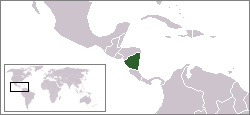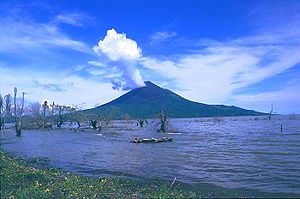This is an old revision of this page, as edited by 200.39.214.224 (talk) at 01:34, 21 May 2005. The present address (URL) is a permanent link to this revision, which may differ significantly from the current revision.
Revision as of 01:34, 21 May 2005 by 200.39.214.224 (talk)(diff) ← Previous revision | Latest revision (diff) | Newer revision → (diff)Nicaragua is a republic in Central America. It is the largest Central American nation but the least densely populated. It is bordered on the north by Honduras and on south by Costa Rica. Its western coastline is on the Pacific Ocean, while the east side of the country is on the Caribbean Sea. The country's name is a combination of Nicarao, the most populous indigenous tribe when the Spanish arrived, and the Spanish word Agua, meaning water, after the two large lakes in the west of the country, Lago Managua and Lago Nicaragua.
| |||||
| National motto: Pro Mundi Beneficio (Latin: For the World's benefit) | |||||

| |||||
| Official language | Spanish (official) (English and indigenous languages on Atlantic coast) | ||||
| Capital | Managua | ||||
| Mayor of the Capital | Herty Lewites | ||||
| President | Enrique Bolaños | ||||
| Area - Total - % water |
Ranked 115th 129,494 km² 2.9% | ||||
| Population - Total - Density |
Ranked 131st 5,628,517 38,80/km² | ||||
| Independence - Declared - Recognized |
From Spain September 15, 1821 July 25, 1850 | ||||
| Currency | Córdoba | ||||
| Time zone | UTC -5 | ||||
| National anthem | Salve a tí | ||||
| Internet TLD | .ni | ||||
| Calling Code | 505 | ||||
History
Main article: History of Nicaragua
Colonized by Spain in 1524, Nicaragua achieved independence as an independent state in 1821 and joined the United Provinces of Central America. It separated from the federation in 1838, becoming a completely sovereign republic in 1854.
The nation's early history was marked by the desire of U.S. governments commercial interests to make use of Nicaraguan territory. When gold was discovered in California, Cornelius Vanderbilt's Accessory Transit Company undertook a steamship and carriage business to link Greytown, at the mouth of the San Juan River (linking the Lago Nicaragua with the Gulf of Mexico), to the Pacific.
Nicaragua was one of the richest countries in America in the 18 and 19 century. The conservator governments become the country in a modern nation. Zelaya followed the modernization but was a dictatorial government. Nicaragua has seen U.S. military interventions and lengthy periods of military dictatorship: Somoza family (supported by U.S. governments) for much of the early 20th century. In 1979 the Somoza family was deposed, and a multi-factional coalition took control of the government. Conflicts within the coalition eventually resulted in power being consolidated by other dictatorship Daniel Ortega, who was elected President in 1984. Ortega and his Sandinista followers implemented a series of dictatorial reforms to the country, the destroyed the liberty. A lot of people were inadequately expropriated of his own. The economy and social structure in Nicaragua was severously damaged in the Daniel Ortega (Sandinista) age. The society in Nicaragua was broked up, and a third part of the country (the most illustrated and rich) emigrated. Sandinistas today are the most rich people in Nicaragua and this is contrasting with the incipient economy. Violeta Chamorro brought to Nicaragua the liberty and the develop again. Since Violeta Chamorro, the country has improved little by little.
Multi-party elections were held in 1990, and the country has retained a fairly stable democracy since then.
Politics
Main article: Politics of Nicaragua
Nicaragua is a constitutional republic with an elected president holding executive power. The unicameral legislative body is the National Assembly, which has 93 members elected for 5-year terms. The President, and the runner-up are both members of the National Assembly, as well, and the government operates according to pseudo-parliamentary rules.
Departments
Main article: Departments of Nicaragua
http://www.volcano.si.edu/world/volcano.cfm?vnum=1404-11=
For administrative purposes, Nicaragua is divided into 15 departments and two autonomous regions. The departments are Boaco, Carazo, Chinandega, Chontales, Estelí, Granada, Jinotega, León, Madriz, Managua, Masaya, Matagalpa, Nueva Segovia, Rivas, Río San Juan. The two autonomous regions are Región Autónoma del Atlántico Norte and Región Autónoma del Atlántico Sur, often referred to as RAAN and RAAS respectively. Until they were granted autonomy in 1985 they formed the single department of Zelaya.
http://www.granada.com.ni/home.html
Geography
Main article: Geography of Nicaragua
Nicaragua has three distinct geographical regions: the Pacific Lowlands, the North-Central Mountains and the Mosquito Coast. The Pacific Lowlands are in the west of the country, and consist of a broad, hot, fertile plain which supports most of Nicaragua's population. The capital, Managua, and the two main provincial cities, Leon and Granada all lie in this region. Punctuating this plain are several large volcanoes, many of which are active. Volcanic eruptions and earthquakes are common in this part of the country: much of central Managua was destroyed by an earthquake on December 23 1972.
The North-Central mountains is an upland region away from the Pacific coast, with a cooler climate than the Pacific Lowlands. About a quarter of the country's agriculture takes place in this region, with coffee grown on the higher slopes.
The Mosquito Coast is a large rainforest region, with several large rivers running through it. It has a hot and humid climate, and is very sparsely populated. The Caribbean coastline is much more sinuous than its generally straight Pacific counterpart: lagoons and deltas make it very irregular.
See also:

http://www.sanjuandelsur.org.ni
Economy
Main article: Economy of Nicaragua

Nicaragua's economy has historically been based on the export of cash crops such as bananas, coffee and tobacco. It boasts the best rum in Central America and is 3rd in beef quality behind Argentina and Brazil. During the Contra War, much of the country's infrastructure was damaged or destroyed, and an economic blockade by the US led to the virtual collapse of the economy. Inflation ran for a time at several thousand per cent. Since the end of the war, many state-owned industries have been privatised. Inflation has been brought to manageable levels, and the economy has grown quite rapidly in recent years. The country is still the second-poorest in the Americas, however, and is struggling to implement further reforms, on which aid from the International Monetary Fund is conditional.
As in so many poor countries at world-wide level, most of the poor people in Nicaragua are women. In addition, a relatively high percentage of the Nicaraguan homes have a woman as head of household: 39% of urban homes and 28% of the rural ones. (From The Role of Woman in the Economy - used by permission of the site author.)
Demographics
Main article: Demographics of Nicaragua
About 86 per cent of Nicaraguans are European (but not limited to Spanish) or mixed European and indigenous ancestry. They are mostly of Spanish descent, but the 19th century saw several small waves of immigration from other European-Mediterranean countries. Most of the Mestizo and European population live in the western regions of the country and especially in the cities of Managua, Leon and Granada.
About 9 per cent of Nicaragua's population is black or afronicaragüense, with the black population concentrated on the country's eastern coast. The black population is mostly of West Indian origin, the descendents of indentured labourers brought mostly from Jamaica and Haiti when the region was a British protectorate. There is also a smaller number of Garifuna, a people of mixed African, Carib, Angolan, Congoan and Arawak descent.
Just 5 per cent of the population are of pure indigenous descent. Nicaragua's pre-Colombian population consisted of the Nahuatl-speaking Nicarao people of the west, and six ethnic groups including the Miskitos, Ramas and Sumos in the Caribbean region. While very few pure-blooded Nicarao people still exist, the Caribbean peoples have remained distinct. In the mid-1980s, the government divided the eastern half of the country - the former department of Zelaya - into two autonomous regions and granted the African and indigenous people of the region limited self-rule.
There is also a small Middle Eastern-nicaraguan community of Syrian, Armenian, Palestinian and Lebanese people in Nicaragua with a total population of about 30,000, and an East Asian community of Japanese, Taiwanese and Chinese people of almost 8,000. The minorities speak Spanish and maintain their ancestral languages as well.
Spanish is spoken by about 90% of Nicaraguans; the Nicaraguan dialect has many similarities to Galician, and also has similarities to Argentinian Spanish which uses "vos" instead of "tu", along with the "vos" conjugation. The black population of the east coast region has English as its first language. Several indigenous peoples of the east still use their original languages.
Roman Catholicism is the major religion, but evangelical Protestant groups have grown recently, and there are strong Anglican and Moravian communities on the Caribbean coast.
Ninety per cent of Nicaraguans live in the Pacific lowlands and the adjacent interior highlands. The population is 54% urban.
Culture
Main article: Culture of Nicaragua
http://www.manfut.org/managua/tiscapa.html
Nicaraguan culture has several distinct strands. The west of the country was colonized by Spain and has a similar culture to other Spanish-speaking Latin American countries. The people of western Nicaragua are mostly Europeans and Mestizo; Spanish is invariably their first language.
The eastern half of the country, on the other hand, was once a British protectorate. English is still the first language of most people in this region, and its culture is more similar to Caribbean nations. There is a large population of people of African descent, as well as a smaller Garifuna population.
Of the cultures that were present before European colonization, the Nahuatl-speaking peoples who populated the west of the country have essentially been assimilated into the latino culture. In the east, however, several indigenous groups have maintained a distinct identity. The Sumos and Ramas people still use their original languages.
Miscellaneous topics
- Nicaraguan Cuisine
- Nicaraguan Diaspora
- Communications in Nicaragua
- Transportation in Nicaragua
- Military of Nicaragua
- Foreign relations of Nicaragua
Famous Nicaraguans
- Ruben Dario
- Violeta Chamorro
- Fransisco Hernandez de Córdoba
- Erwin Kruger
- Salomón de la Selva
- Pablo Antonio Cuadra
- Carlos Mejía Godoy
- Luis Enrique
- Luis Enrique Mejía Godoy
- Camilo Zapata
- Silvia Poll
- Bianca Jagger
- Michael Cordua
- Michele Najlis
- Ernesto Cardenal
- Arlen Siu
- Gioconda Belli
- Daniel Ortega Saavedra
External links
| Countries and dependencies of North America | |||||||||||||
|---|---|---|---|---|---|---|---|---|---|---|---|---|---|
| Sovereign states |
| ||||||||||||
| Dependencies |
| ||||||||||||